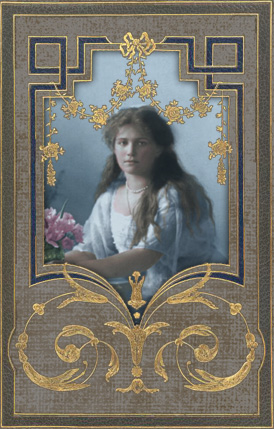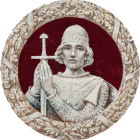Here is an article about my ancestor, the Earls of Orkney, and his trip to Kiev, capital of ancient Russ when it ws ruled by Vikings







CHAPTER 4
CONCERNING ST. PETERSBURG
A FEW weeks after my arrival in Russia we went to Tsarskoe Selo-the name means "The Tsar's borough." It is a pretty little town, surrounded by great forests, and has a population of a couple of thousand souls. The forests are for the most part evergreen, though there are also silver birch, oak, and ash. trees. There are two palaces in this little town. The Great, or Catherine's Palace, and the Little, or Alexander's Palace, which she built for her grandson, Alexander I. We resided in the latter. It is a white Grecian building with a green roof. It is situated in a pretty park, and stands quite close to the road. It has two wings and the main body. In one wing live the Emperor, Empress, and the children, with their households. When I first went to Russia the children's suite was small, though pretty, but now the nurseries at Tsarskoe Selo are very fine, consisting of about eleven rooms. In the bathroom is a stationary bath of solid silver, used for the bigger children. There is a small silver bath for the use of whatever baby reigns. Each child's name is engraved upon it, so it forms a historical record. It was apparently bought for Nicholas I., and bears his name and those of his family. We also find the names of Alexander II., and of Marie, afterwards Duchess of Edinburgh. The last name added was that of Alexis, the little baby who was born in August, 1904.
The walls of all the new rooms are painted in oil with beautifully executed friezes of the same flowers as appear in the chintz, interspaced with golden butterflies or birds. The bathroom has sea-gulls painted on the frieze. At the end of this suite is the play room. It has eight windows overlooking the park and gardens. It is all yellow and green, like a bunch of daffodils, and has a frieze of peacocks strutting about amidst greenery. The carpet is a pale sage green, unpatterned. Over each window is a panel, in painted poker work, each representing some scene in animal or bird life. There are two fireplaces in this great room, but as the rooms are all heated with hot air, the fires are not required excepting for ventilation.
Catherine II. must have loved lilac, for the parks at Tsarskoe Selo are full of it. There are as many as eight different varieties, and in the summer evenings the perfume is delicious. I have been told that she sent into all countries and paid fabulous prices for some of the specimens. However, they have repaid the trouble she took. In some places the bushes look like great bouquets, so full and round are they, and there are several avenues lined on each side with it.
The park is fourteen miles in circumference. Catherine had very good ideas about laying out a park or gardens, also the building of a palace. There are great halls and state-rooms lined with marble. There is a great deal of pale-blue marble which is so exceedingly rare; also pink and yellow marble. The person who "Dreamt that she dwelt in marble halls" might awaken there and find her dream realised.
The great palace contains the far famed Amber-room. All the walls are inlaid with mosaic work of amber in different shades. Chairs, tables, and ornaments are carved in it. This room was prepared by her father for one of the former Empresses of Russia. President Loubet had a suite of rooms in this palace. There are many fine pictures. There is a great banqueting hall with twenty-eight windows in it, and here is the church which the Imperial family attend.
Between the two parks are the Little Caprice and the Great Caprice. The story goes that on one occasion Catherine II., walking with a favourite and trusted Minister in the park, complained of the flatness of the country, saying that it would give her great pleasure to come out the following morning and find a hill just where she stood. To hear was to obey. The minister started work immediately. The entire population of the country side was impressed. The work was carried on throughout the night, an arched way of stone was raised across the road, by excavating and digging, and a hill actually appeared before morning. This hill was afterwards covered with trees and shrubs.
Catherine II. was an autocrat. She had a great objection to members of her household getting married. On one occasion a lady and gentleman belonging to her suite became engaged. For a long time Catherine refused her consent to their marriage, but finally agreed on the express condition that she was allowed to make all arrangements for the wedding. To this proposition they gladly consented. The ceremony concluded, she led the way down to the frozen Neva, where she had caused an ice house to be built. In this terrible abode she incarcerated them. Months after, when the Neva was in flood, their dead bodies were recovered and buried.
The Great Caprice is crowned by a Chinese pagoda, and in the park are Chinese bridges, a model of a Chinese village, and a theatre in the Chinese style. Even in Catherine's reign the Far East seemed to have attractions for the Russian mind. It is more than a hundred years since she died, and the cost of producing and bringing all these things from China must have been enormous. In Gatchina, the Dowager Empress's place in the Duderhoff hills, there is a Chinese gallery, all the contents of which were collected by Paul I., Catherine's most unhappy son.
Paul was a curious mixture. Some of his laws only came into force within the past ten years, and are wise and good. He ordained that only the children and grandchildren of Emperors should bear the title of Grand Duke, and have an allowance from the country. After that they should be known as Prince and Princess, with the Christian name; they should then have no allowance from the country and should be free to marry amongst the nobility. On the other hand, he had so exalted an opinion of his own importance that he commanded that when his carriage or sleigh passed all other carriages they should be brought to a standstill and the occupants should kneel on the road, without regard to age, sex, or infirmity.
Koskiusko, the Polish rebel, lived in his reign. He was arrested and imprisoned, and we find Paul liberating him on his promise never again to take up arms against him. Koskiusko loyally kept his word and refused to join in any plot for the liberation of his country.
A man of such an extraordinary character as Paul could hardly have been an unmixed blessing in the domestic circle. He was twice married and had a large family. Two of his sons, Alexander and Constantine, formed a resolution to force him to resign. With this object in view the sons entered the palace one night, each at the head of his regiment. They stationed themselves in the rooms at either side of Paul's bedroom, and sent in a deputation to try to prevail upon him to resign the crown in favour of his eldest son Alexander. It is probable that he could not see the rights of his eldest son so clearly as Alexander did, so the deputation, being unsuccessful, found a pillow a handy argument, and smothered him. When they left the room they gave orders that Alexander was forthwith to be proclaimed Emperor as the old Emperor was dead.
Alexander I. had no children. His end is uncertain; he died suddenly on a voyage. For some unknown reason there was no lying in state, nor was the body embalmed, so the peasants throughout Russia believed that he did not die but went on a pilgrimage to Siberia, that his life has been miraculously lengthened out, and at some time when Russia has need of him he will come forth and vanquish his enemies, as he defeated Napoleon Bonaparte. There is reason to believe that he committed suicide and his face was too much disfigured to be seen.
He was succeeded by his younger brother Nicholas, against whom England fought in the Crimean War. Constantine should have succeeded Alexander, but he had fallen in love with and married a Polish countess, therefore renounced his claim to the throne.
Peter the Great, and all his successors with one exception, lie in the Fortress Church of St. Peter and St. Paul in St. Petersburg. This church is kept in most beautiful order. Fresh flowers are always there, and the holy lamps are kept burning continually on the tombs. The church itself is very pretty and contains many specimens of Peter the Great's work. Indeed, we find so much work attributed to him that the question arises, "How did he find time for so much handicraft?".



